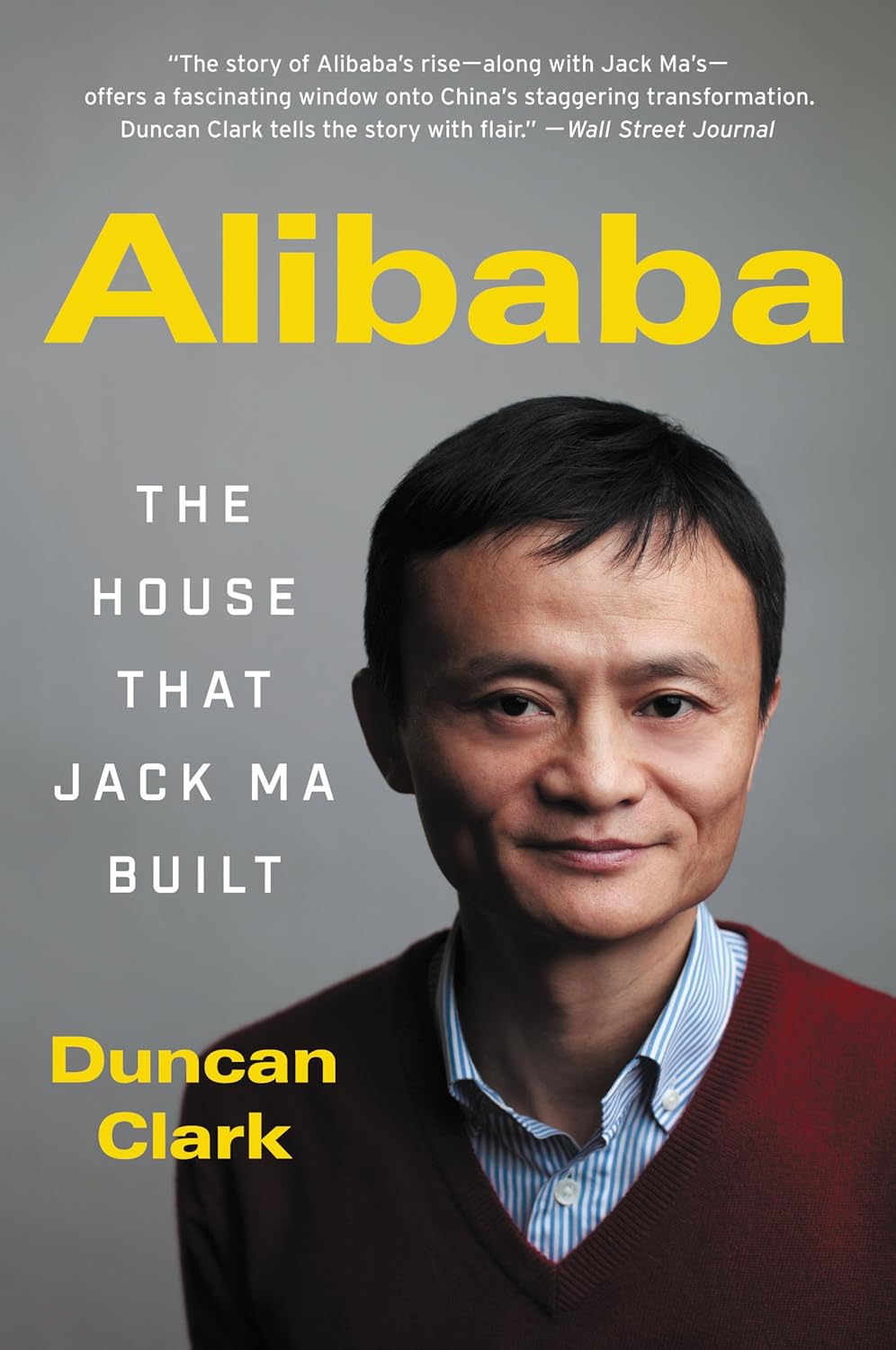Duncan Clark offers an intimate and comprehensive account of the rise of Alibaba, one of the world’s most influential technology companies, and its charismatic founder, Jack Ma. Clark, who was an early adviser to Ma and a long-time observer of China’s internet industry, provides an insider’s perspective on the challenges, triumphs, and strategic decisions that shaped Alibaba’s trajectory from a humble startup in a Hangzhou apartment to a global e-commerce and technology behemoth.
The book chronicles not only the company’s growth but also the parallel transformation of China’s digital landscape and the unique leadership philosophy of Jack Ma.
Introduction
The introduction immediately sets the stage for the extraordinary story of Alibaba and its founder, Jack Ma. Clark describes Alibaba as an “unusual name” for a company that would grow to dominate China’s internet economy.
He emphasizes Ma’s unlikely background—an English teacher with no technical expertise—who defied conventional wisdom to build a colossal enterprise.
The introduction highlights the sheer scale of Alibaba’s ambition and impact, touching upon its diverse ecosystem spanning e-commerce (Taobao, Tmall), payments (Alipay), logistics, cloud computing (Alibaba Cloud), and entertainment.
Clark posits that understanding Alibaba is crucial for comprehending China’s economic and technological ascent, and indeed, the future of the global digital landscape. He hints at the unique blend of ambition, resilience, and a distinct “Jack Magic” that propelled Alibaba’s success, promising to delve into the intricate relationship between the company, its founder, and the evolving Chinese market.
Chapter One: The Iron Triangle
This chapter lays the foundational context for understanding Alibaba’s emergence by introducing the “Iron Triangle” of China’s internet—a powerful triumvirate composed of Tencent (social media and gaming), Baidu (search), and Alibaba (e-commerce and payments).
Clark explains how these three companies, often referred to as BAT, came to define China’s digital economy, each carving out its own domain while often competing and collaborating in complex ways.
He discusses the unique characteristics of the Chinese internet market, distinct from the Western model dominated by Google, Amazon, and Facebook. This includes the absence of many foreign internet giants due to regulatory barriers and local competition, creating a fertile ground for domestic players.
The chapter also touches upon the rapid adoption of mobile internet in China, which allowed companies like Alibaba to leapfrog traditional infrastructure development and reach a vast population.
Chapter Two: Jack Magic
“Jack Magic” delves into the early life and formative experiences of Jack Ma, painting a picture of an improbable entrepreneur.
Clark describes Ma’s humble beginnings, his repeated failures in early attempts at higher education and job applications, and his initial foray into the internet world in the mid-1990s. Despite his lack of technical background, Ma possessed an unparalleled vision for the internet’s potential in China and an extraordinary ability to inspire and motivate others.
Clark highlights Ma’s charismatic personality, his unconventional leadership style, and his relentless optimism, even in the face of daunting odds.
This chapter explores how Ma’s unique blend of persistence, storytelling prowess, and an innate understanding of human psychology allowed him to rally support, attract talent, and persuade investors, laying the groundwork for Alibaba’s future success.
Chapter Three: From Student to Teacher
This chapter traces Jack Ma’s journey from an English teacher in Hangzhou to his initial encounters with the internet.
Clark details Ma’s first trip to the United States in 1995, where he was introduced to the internet and immediately recognized its revolutionary potential for connecting Chinese businesses with the global market. Upon his return, Ma founded China Pages, one of China’s first internet companies, aimed at building websites for businesses.
This early venture, though ultimately unsuccessful in the long run due to a partnership with state-owned China Telecom that turned sour, provided Ma with invaluable lessons about the internet business, dealing with bureaucracy, and the importance of speed and agility. It was through this experience that Ma transitioned from being a mere “student” of the internet to an evangelist and “teacher,” sharing his vision with others and building a core team of loyal followers.
Chapter Four: Hope and Coming to America
Following the experience with China Pages, Ma and his team remained undeterred. This chapter details their next ventures and the continued quest for funding and partnerships.
Clark describes Ma’s persistence in convincing potential investors and partners, often facing skepticism due to China’s nascent internet infrastructure and his non-technical background.
The title “Coming to America” refers to Ma’s efforts to learn from the booming dot-com industry in the U.S. and to seek capital from American investors.
Despite initial rejections, Ma’s unwavering belief in the internet’s future in China eventually attracted attention. This period was crucial for refining his vision for an e-commerce platform that would empower small and medium-sized enterprises (SMEs), a demographic largely ignored by larger players.
Chapter Five: China Is Coming On
This chapter marks a pivotal moment in Alibaba’s history: the decision to launch Alibaba.com in 1999 from Ma’s apartment in Hangzhou, backed by a small group of loyal co-founders (the “Eighteen Arhats”).
Clark explains how the name “Alibaba,” inspired by the “Open Sesame” story, symbolized their aim to open doors for small businesses.
This period coincided with China’s rapid economic growth and increasing integration into the global economy.
The chapter details the early struggles, the lean startup mentality, and the unwavering dedication of the founding team. It emphasizes how Alibaba.com, a B2B (business-to-business) platform, capitalized on China’s manufacturing prowess and its growing role as the “world’s factory,” connecting Chinese suppliers with international buyers.
Chapter Six: Bubble and Birth
This chapter covers the tumultuous period of the dot-com bubble burst in the early 2000s and, paradoxically, the “birth” of some of Alibaba’s most critical innovations. While many internet companies collapsed globally, Alibaba managed to not only survive but also to innovate
Clark explains how the company navigated the downturn by focusing on its core value proposition for SMEs and implementing stringent cost controls. Crucially, this period saw the conceptualization and launch of Taobao.com in 2003, Alibaba’s consumer-to-consumer (C2C) platform, in direct response to the SARS epidemic that limited physical interactions and accelerated online adoption.
This chapter also details the development of Alipay, Alibaba’s secure online payment system, a vital component for building trust in China’s burgeoning e-commerce market where credit card penetration was low.
These innovations were born out of necessity and a deep understanding of local market conditions.
Chapter Seven: Backers: Goldman and SoftBank
This chapter highlights two crucial early investors who provided the financial and strategic backing that allowed Alibaba to scale rapidly: Goldman Sachs and SoftBank. Clark details how Goldman Sachs was an early institutional investor, recognizing the potential of Alibaba’s unique business model and Jack Ma’s vision.
More significantly, he recounts Masayoshi Son of SoftBank’s groundbreaking decision to invest a substantial sum in Alibaba in 2000, a move that secured SoftBank a significant stake in the company and provided Alibaba with the capital needed to weather the dot-com bust and expand aggressively.
Son’s trust in Ma, despite the unproven nature of the Chinese internet market at the time, proved to be one of the most successful venture capital investments in history. This backing was critical for Alibaba to withstand fierce competition and pursue ambitious expansion plans.
Chapter Eight: Burst and Back to China
This chapter circles back to the consequences of the dot-com bubble’s “burst” but focuses on how Alibaba, unlike many others, not only survived but thrived by strategically refocusing on its core Chinese market.
While some Chinese internet companies sought to emulate Western models, Alibaba’s success was largely due to its “Back to China” philosophy—tailoring its services specifically for the unique characteristics and needs of Chinese consumers and businesses.
This included developing solutions for low credit card penetration (Alipay), creating a C2C platform (Taobao) that directly challenged eBay’s entry into China, and building a logistics network from the ground up. This strategic localization, combined with relentless execution, proved to be Alibaba’s competitive advantage.
Chapter Nine: Born Again: Taobao and the Humiliation of eBay
This is a pivotal chapter describing Alibaba’s strategic masterpiece: the decisive victory of Taobao over eBay in China. When eBay entered China with its established global brand and deep pockets, it seemed poised to dominate. However, Jack Ma and the Taobao team launched a daring counter-strategy.
Clark details how Taobao differentiated itself by offering free listings (unlike eBay’s paid model), focusing heavily on building trust through Alipay, and crucially, by deeply understanding Chinese consumer behavior and preferences.
Taobao quickly built a vibrant online community, fostered social interaction between buyers and sellers, and adapted its platform to local needs.
The chapter vividly recounts how this localized, user-centric approach led to eBay’s eventual “humiliation” and retreat from the Chinese C2C market, cementing Alibaba’s dominant position and proving the efficacy of Ma’s “customer first” philosophy.
Chapter Ten: Yahoo’s Billion-Dollar Bet
This chapter explores another significant turning point: Yahoo’s strategic investment in Alibaba in 2005. Clark details how Jerry Yang, co-founder of Yahoo, saw the immense potential in Alibaba and its future dominance in China.
Yahoo made a staggering billion-dollar investment in exchange for a significant stake in Alibaba and control over Yahoo China operations. This deal provided Alibaba with crucial capital and a strong international partner, further boosting its legitimacy and expansion capabilities.
However, the relationship between Alibaba and Yahoo proved complex and at times contentious over the years, marked by differing visions and cultural clashes.
Despite the tensions, this “billion-dollar bet” was instrumental in fueling Alibaba’s subsequent growth and preparing it for its eventual global public offering.
Chapter Eleven: Growing Pains
As Alibaba continued its meteoric rise, it inevitably faced “growing pains.” This chapter delves into the challenges that come with scaling a massive organization, managing a diverse ecosystem of businesses, and navigating an increasingly complex regulatory environment.
Clark discusses issues such as ensuring quality control across vast numbers of sellers, combating counterfeit goods, maintaining the entrepreneurial spirit within a large corporation, and adapting to new competitive threats from players like Tencent and JD.com.
It also touches upon the internal conflicts and leadership transitions that occurred as Alibaba matured, highlighting the constant need for adaptation and evolution to sustain growth and maintain its innovative edge.
Chapter Twelve: Icon or Icarus?
The final chapter offers a reflective look at Jack Ma’s legacy and Alibaba’s future, posing the question: “Icon or Icarus?” Clark discusses Ma’s transformation from a quirky English teacher to a global business icon, revered by millions in China and admired internationally.
He explores the philosophical underpinnings of Ma’s leadership, his focus on “doing good” while doing business, and his unique blend of strategic vision and spiritual rhetoric. However, the “Icarus” part of the question alludes to the potential pitfalls of immense success—the risk of becoming too big, too powerful, or losing touch with the entrepreneurial spirit that defined its early days.
Clark delves into the challenges Alibaba faces as it navigates increased scrutiny from Beijing, intensifies competition in new sectors, and strives to maintain its relevance in a rapidly changing world. The chapter concludes by acknowledging Ma’s profound impact and the enduring power of the “House That Jack Ma Built,” while leaving the ultimate trajectory open to the forces of time and market dynamics.
A final word
In “Alibaba: The House That Jack Ma Built,” Duncan Clark delivers a compelling and meticulously researched narrative that goes beyond a mere corporate history. It is a story about vision, resilience, leadership, and the unique alchemy that allowed an audacious entrepreneur from a developing nation to build a global empire that redefined commerce and technology. Clark’s insider perspective, combined with his deep understanding of China’s economic and political landscape, makes this book an essential read for anyone seeking to comprehend the forces shaping the global digital economy and the enduring legacy of one of its most fascinating figures.


